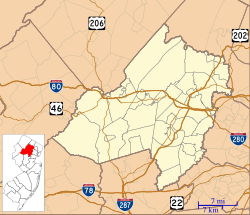Peter Kemble House | |
 | |
| Location | Mount Kemble Avenue at Old Camp Road Harding Township, New Jersey |
|---|---|
| Nearest city | Morristown, New Jersey |
| Coordinates | 40°45′30″N74°31′27″W / 40.75833°N 74.52417°W |
| Built | c. 1750 |
| Architectural style | Georgian |
| Part of | Tempe Wick Road–Washington Corners Historic District (ID00000959) |
| NRHP reference No. | 80002510 [1] |
| NJRHP No. | 2125 [2] |
| Significant dates | |
| Added to NRHP | August 26, 1980 |
| Designated CP | August 25, 2000 |
| Designated NJRHP | January 29, 1973 |
The Peter Kemble House is a historic house built around 1750 and located on Mount Kemble Avenue (U.S. Route 202) at Old Camp Road in Harding Township, New Jersey. It was documented by the Historic American Buildings Survey in 1937. [3] It was added to the National Register of Historic Places on August 26, 1980 for its significance in commerce, military history, and government. [4] The Georgian style house was added as a contributing property of the Tempe Wick Road–Washington Corners Historic District on August 25, 2000. [5]




